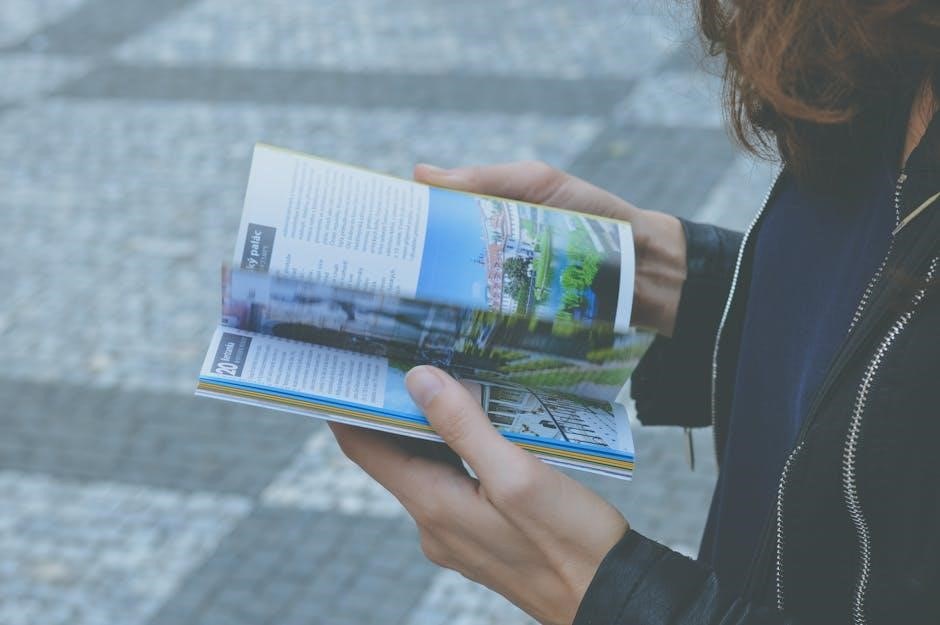A comprehensive resource for planning and navigating the Camino de Santiago, offering detailed maps, route descriptions, accommodation tips, packing advice, and insights into history and spirituality.
Overview of the Camino de Santiago
The Camino de Santiago is a network of pilgrimage routes leading to Santiago de Compostela, Spain. It’s a journey steeped in history, spirituality, and culture, attracting pilgrims worldwide. Whether for religious devotion or personal growth, the Camino offers a transformative experience. The most popular route, Camino Francés, spans from France to Spain, while other routes like Camino Portugués and Camino del Norte provide diverse landscapes. Pilgrims carry a passport, collecting stamps at albergues and churches. The journey emphasizes reflection, connection with nature, and camaraderie among travelers. Guidebooks are invaluable for navigating routes, understanding history, and planning logistics.
Why Use a Guide Book for the Camino de Santiago?
A guidebook is an invaluable resource for planning and navigating the Camino de Santiago. It provides detailed maps, route descriptions, and practical tips, helping pilgrims avoid rookie mistakes. Guidebooks like John Brierley’s Pilgrim’s Guide offer insights into history, culture, and spirituality, enriching the journey. They also list albergues, restaurants, and landmarks, making logistics easier. While digital tools are convenient, a physical guidebook offers a tangible, offline reference. Top recommended guidebooks include Brierley’s and Beebe Bahramis’, ensuring pilgrims are well-prepared for their transformative adventure. Whether for first-timers or seasoned travelers, guidebooks enhance the Camino experience.

History and Significance of the Camino de Santiago
The Camino de Santiago, rooted in the 9th-century discovery of St. James the Apostle’s tomb, became a major pilgrimage route during the Middle Ages, blending faith, culture, and history.
Historical Background of the Pilgrimage
The Camino de Santiago traces its origins to the 9th century with the discovery of St. James the Apostle’s tomb in Santiago de Compostela, Spain. This event sparked a religious movement, drawing pilgrims across Europe. By the Middle Ages, it became one of Christianity’s most important pilgrimage routes, alongside Rome and Jerusalem. The Camino’s popularity grew as churches and monasteries were built along the way, offering refuge and spiritual guidance. Over centuries, the pilgrimage evolved, blending religious devotion with cultural and social interactions, making it a timeless journey of faith and discovery.
Religious and Cultural Significance
The Camino de Santiago holds profound religious and cultural significance, symbolizing a journey of faith, reflection, and spiritual renewal. For centuries, pilgrims have walked to Santiago de Compostela to honor St. James, with the scallop shell becoming a universal symbol of this pilgrimage. Beyond its religious roots, the Camino fosters a sense of community among pilgrims from diverse backgrounds, creating a cultural tapestry enriched by shared experiences. The route is dotted with historic churches and landmarks, blending spiritual devotion with cultural heritage, making it a unique and transformative experience for all who undertake it.
Popular Routes of the Camino de Santiago
The Camino de Santiago features several popular routes, including the Camino Francés, Camino Portugués, and Camino del Norte, each offering unique landscapes and challenges for pilgrims.
Camino Francés: The Most Popular Route
The Camino Francés, stretching 780 kilometers from Saint-Jean-Pied-de-Port to Santiago de Compostela, is the most-traveled route, known for its well-marked paths and rich history. It passes through diverse regions, including Navarra, La Rioja, and Castilla y León, offering stunning landscapes and cultural landmarks. Pilgrims appreciate its Infrastructure, with numerous albergues and amenities. While popular, it can be crowded during peak seasons. Many guidebooks, like John Brierley’s, provide detailed insights, though some question the accuracy of ascent data. This route is ideal for first-time pilgrims, blending spirituality with practicality, making it a timeless choice for those embarking on the Camino journey.
Camino Portugués: The Portuguese Way
The Camino Portugués, originating in Portugal, is the second most popular route, offering a lighter, 610-kilometer journey from Lisbon or Porto to Santiago. Renowned for its serene landscapes and historical sites like Fátima, it provides a tranquil experience with fewer crowds. Pilgrims enjoy the balanced mix of rural and urban settings, making it ideal for those seeking both solitude and cultural immersion. Its manageable terrain and rich heritage attract a diverse group of travelers, ensuring a unique and enriching pilgrimage experience.
Camino del Norte: The Northern Route
Camino del Norte, or the Northern Route, is a less-traveled yet stunning path along Spain’s northern coast, offering breathtaking ocean views and charming coastal towns. Stretching approximately 835 kilometers, it begins in Irún and winds through regions like the Basque Country and Asturias. Known for its rugged terrain and cooler climate, this route appeals to those seeking solitude and a deeper connection with nature. Pilgrims can explore historic sites, enjoy fresh seafood, and experience the unique culture of northern Spain, making it a rewarding choice for adventurous spirits.
Other Lesser-Known Routes
Beyond the popular Camino Francés, Portugués, and Norte, there are lesser-known routes offering unique experiences. The Camino Primitivo, the original pilgrimage path, is rugged and scenic. The Camino Inglés, starting in Ferrol or A Coruña, is shorter and rich in maritime history. The Camino de San Salvador connects Oviedo to Lugo, featuring stunning mountain landscapes. These routes provide quieter trails, allowing pilgrims to immerse themselves in untouched natural beauty and authentic local cultures, making them ideal for those seeking solitude and a deeper connection with the Camino’s essence.
Planning Your Camino de Santiago Journey
Planning your Camino involves selecting routes, budgeting, and preparing physically. Guidebooks and apps provide maps, accommodation tips, and insights, helping you navigate this transformative journey seamlessly.
How to Choose the Right Route for You
Choosing the right Camino route depends on your preferences, fitness level, and time. The Camino Francés is ideal for first-timers, offering well-marked paths and vibrant pilgrim communities. For a quieter experience, the Camino del Norte provides stunning coastal views. The Camino Portugués is perfect for those seeking a mix of culture and nature. Consider the distance, terrain, and your physical preparedness. Guidebooks and online resources offer detailed insights to help you select a route that aligns with your goals and ensures a fulfilling pilgrimage experience.
Best Time to Walk the Camino
The best time to walk the Camino de Santiago is in spring (March-May) and autumn (September-November), when temperatures are mild and comfortable for hiking. These seasons offer vibrant landscapes and fewer crowds compared to summer. Spring blooms with wildflowers, while autumn provides golden hues and harvest scenery. Summer can be hot, especially in central Spain, but it’s the busiest period. Winter is quieter but colder, with some albergues closing. Plan according to your preference for weather, crowd levels, and personal comfort to ensure an enjoyable pilgrimage experience.
Understanding the Duration and Distance
The Camino de Santiago varies in duration and distance depending on the route. The most popular route, Camino Francés, stretches approximately 780 kilometers and takes about 30-35 days to complete. Distances are typically divided into daily stages, averaging 20-25 kilometers. Other routes, like Camino Portugués, are shorter, around 610 kilometers, taking 25-30 days. The duration depends on your physical condition, walking pace, and how many rest days you take. Planning your itinerary according to your schedule and abilities ensures a manageable and enjoyable journey. This allows you to fully immerse in the experience without feeling rushed or overwhelmed.
Packing Essentials for the Camino de Santiago
Packing lightly and smartly is crucial. Bring a sturdy backpack, moisture-wicking clothing, durable footwear, and essentials like trekking poles and a first-aid kit for comfort and safety.
Choosing the Right Backpack
Selecting the right backpack is crucial for comfort and practicality. Opt for a lightweight, durable bag with padded shoulder straps and a hip belt to distribute weight evenly. A capacity of 30-40 liters is ideal for most pilgrims, allowing space for essentials without overpacking. Look for weather-resistant material and multiple compartments for organization. Ensure the backpack fits your body comfortably, as improper sizing can lead to discomfort or injury. Consider gender-specific designs for better fit. While hiking backpacks are popular, some prefer travel bags with wheels for versatility. Test your backpack before the journey to ensure it meets your needs.
Essential Clothing and Footwear
Choosing the right clothing and footwear is vital for a comfortable Camino journey. Opt for breathable, moisture-wicking fabrics to keep you cool and dry. Include lightweight rain gear for unexpected showers. Select sturdy, waterproof hiking boots or shoes with excellent support and traction, suitable for varied terrain. Bring multiple pairs of moisture-wicking socks to prevent blisters. Layering clothing is key for changing weather conditions. Consider quick-drying pants and a hat for sun protection. Ensure your footwear is well broken-in before starting your pilgrimage to avoid discomfort and injuries. Comfortable footwear is essential for enduring long daily walks.
Other Must-Have Items for the Journey
Beyond clothing and footwear, essential items for the Camino include a reliable backpack, a reusable water bottle, and a portable charger for your devices. A first-aid kit is crucial for treating minor injuries and blisters. Pack a lightweight torch or headlamp for early mornings and evenings. Bring a travel-sized toiletry bag with basics like sunscreen and hand sanitizer. A guidebook or map is invaluable for navigation, while a journal can help document your experiences. Don’t forget a pilgrim passport to collect stamps along the way. These items ensure comfort, safety, and memorable experiences throughout your pilgrimage.
Accommodation Options on the Camino
The Camino offers a variety of lodging options, including albergues, hotels, and camping, catering to different budgets and preferences, ensuring pilgrims have safe and comfortable places to rest.
Understanding Albergues (Pilgrim Hostels)
Albergues are the most popular accommodation for pilgrims, offering basic yet affordable lodging. These hostels provide shared dormitories, bunk beds, and communal facilities like bathrooms and kitchens. Many are run by volunteers or religious organizations, requiring a pilgrim’s passport (credencial) for entry. Check-in times are typically afternoon to evening, and stays are limited to one night. Payment is often donation-based or a small fee. Albergues foster camaraderie among pilgrims, creating a unique, communal experience that aligns with the spiritual essence of the Camino. They are ideal for budget-conscious travelers seeking simplicity and connection.
Booking Private Accommodation
Private accommodation offers comfort and privacy for pilgrims seeking a break from communal settings. Hotels, guesthouses, and pensions provide en-suite rooms, better amenities, and often include breakfast. Booking in advance is recommended, especially during peak seasons. Websites like Booking.com and local tourism offices can assist in finding and reserving these options. Private rooms are ideal for rest days or those preferring more comfort. While more expensive than albergues, they offer a well-deserved retreat after a day’s walk, ensuring a restful night’s sleep in a quieter environment.
Camping on the Camino
Camping offers a unique way to connect with nature while walking the Camino. However, it’s important to note that wild camping is often restricted in certain regions. Pilgrims can stay in designated campsites, which provide basic amenities like showers and restrooms. These sites are less common than albergues but offer a peaceful alternative. Camping requires carrying additional gear, such as a lightweight tent and sleeping bag, which can add weight to your backpack. It’s essential to research local regulations and respect the environment by minimizing waste and using biodegradable products. Always check local rules to avoid fines or disturbances.

Health and Safety on the Camino
Ensure physical conditioning, monitor foot health, and stay hydrated. Carry a first-aid kit and know basic injury prevention. Solo pilgrims should stay aware of surroundings and share plans.
Physical Training and Preparation
Building stamina and strength is crucial for the Camino. Start with short walks, gradually increasing distance and weight. Focus on leg and core exercises. Wear proper footwear during training. Incorporate rest days to avoid injury. Pay attention to flexibility and balance. Practice walking on varied terrain to adapt to different surfaces. Mental preparation is equally important—build resilience and patience. A well-conditioned body and mind will enhance your pilgrimage experience and help you embrace the journey fully.
Common Injuries and How to Prevent Them
Blisters, shin splints, and knee pain are common issues on the Camino. Prevent blisters by wearing moisture-wicking socks and well-fitted shoes. Use insoles for added support. Stretch before and after walking to reduce muscle strain. Strengthen core and leg muscles to stabilize knees. Avoid overloading your backpack to minimize pressure on joints. Incorporate rest days and proper footwear to prevent injuries. Address discomfort early to avoid complications. Prioritizing prevention ensures a smoother, more enjoyable pilgrimage experience.
Safety Tips for Solo Pilgrims
Walking the Camino solo can be rewarding but requires extra caution. Research routes beforehand and share your itinerary with someone; Stay aware of your surroundings and avoid walking alone at night. Carry a basic first-aid kit, a phone charger, and emergency contact details. Join pilgrim groups for safer travel and use albergues or well-reviewed accommodations. Trust your instincts and engage with fellow pilgrims for support. The Camino community is known for its camaraderie, making solo journeys feel less isolating and more secure.
Budgeting for the Camino de Santiago
Plan your finances wisely to enjoy the Camino without stress. Estimate costs for accommodation, meals, and transportation, and consider budgeting tips to save money along the way.
Calculating Costs for the Journey
Estimating expenses for the Camino de Santiago requires careful planning. Average daily costs range from €30-€60, covering accommodation, meals, and transportation. Albergues (pilgrim hostels) are budget-friendly, costing €5-€15 per night, while private hotels can range from €40-€80. Meals in local restaurants (menú del día) cost around €10-€15. Transportation, including flights and trains, varies depending on your starting point. Budgeting apps and spreadsheets can help track expenses. Consider setting aside extra for gear, souvenirs, and unexpected costs. Planning ahead ensures a stress-free pilgrimage, allowing you to focus on the journey’s spiritual and personal rewards.
Ways to Save Money on the Camino
Staying in albergues (pilgrim hostels) is cost-effective, with prices ranging from €5-€15 per night. Cooking meals in shared kitchens instead of dining out can save €10-€20 daily. Carry a reusable water bottle and refill at public fountains. Avoid expensive restaurants by purchasing snacks and groceries. Use the credencial for free stays in some albergues. Walk instead of taking taxis or buses for shorter distances. Budgeting apps can help track spending. Consider off-season walking for lower accommodation costs. Use free resources like apps or guidebooks to plan efficiently.
Budgeting for Accommodation and Food
Average daily costs on the Camino range from €20-€40 per person. Budget €10-€15 for accommodation, with albergues offering affordable stays. Food expenses can be managed by preparing meals in shared kitchens, costing around €5-€8 per day; Eating at local bars or restaurants can increase costs to €15-€25 per meal. Snacks and groceries from supermarkets are economical. Plan meals in advance to avoid overspending. Consider budgeting an extra €5-€10 daily for unexpected expenses. Tracking spending with a budgeting app helps maintain financial control throughout the pilgrimage.

The Role of Guidebooks on the Camino
Guidebooks provide essential insights, maps, and tips, enhancing the Camino experience. They offer route details, accommodation options, and cultural highlights, aiding pilgrims in planning and navigation.
Do You Need a Guidebook to Walk the Camino?
A guidebook isn’t strictly necessary to walk the Camino, but it can greatly enhance your experience. Guidebooks provide detailed maps, accommodation listings, and cultural insights, helping you navigate and plan effectively. Many pilgrims find them invaluable for discovering hidden gems and understanding the history behind the route. While digital resources like apps and websites are increasingly popular, a physical guidebook offers a tangible, offline resource. Ultimately, whether to use one depends on your preference for structured guidance or a more spontaneous journey. They remain a trusted companion for many pilgrims.
Top Recommended Guidebooks for the Camino
Several guidebooks stand out for their detailed insights and practical advice. John Brierley’s Pilgrim’s Guide to the Camino de Santiago is a favorite among pilgrims, offering stage-by-stage route descriptions and maps. Beebe Bahrami’s guide is also praised for its cultural and historical depth. For those preferring a minimalist approach, The Camino Made Easy by Karen Armstrong provides concise planning tips. Additionally, The Camino Francés by Gerald Kelly focuses solely on the most popular route. These books are essential resources, helping pilgrims navigate both the physical and spiritual aspects of their journey. Choose one that aligns with your needs for a fulfilling experience.
Using Digital Guides and Apps
Digital guides and apps have become indispensable tools for modern pilgrims. Apps like Gronze and Wise Pilgrim offer real-time information, interactive maps, and the ability to book accommodations. They provide up-to-date details on albergues, restaurants, and trail conditions, helping pilgrims plan and adjust their journey effortlessly. Digital versions of guidebooks, such as John Brierley’s maps, are also available, offering convenience for those who prefer not to carry physical books. While apps enhance the planning and navigation process, many pilgrims still value traditional guidebooks for their depth and personal insights. Together, they create a seamless experience for all types of travelers.
First-Hand Experiences and Tips
First-hand accounts reveal common rookie mistakes, such as overpacking and rushing, while emphasizing the importance of flexibility and embracing the journey’s transformative power and community spirit.
Common Rookie Mistakes to Avoid
New pilgrims often overpack, bringing unnecessary items that add weight and discomfort. Many also underestimate the physical demands, failing to train beforehand, leading to fatigue and injuries. Rushing the journey is another mistake, as the Camino’s essence lies in embracing the experience rather than reaching the destination quickly. Additionally, some neglect to book accommodations in advance, especially during peak seasons, which can result in limited options. Overlooking the importance of proper footwear and not allowing time for rest days are also common errors that can hinder the pilgrimage experience.
Experiences of First-Time Pilgrims
First-time pilgrims often describe their Camino journey as transformative, filled with unexpected challenges and profound personal growth. Many express initial doubts about their ability to complete the pilgrimage but find strength in the supportive community of fellow travelers. The camaraderie and shared experiences create lasting bonds, while the serene landscapes and historical sites inspire reflection. Despite physical fatigue, the sense of accomplishment and spiritual renewal are common themes among those who embark on this journey for the first time, making it a memorable and life-changing adventure.
Lessons Learned from the Camino
Pilgrims often return with invaluable life lessons, such as embracing simplicity, trusting in kindness, and finding joy in the present moment. The Camino teaches resilience, adaptability, and the importance of community. Many learn to let go of material attachments and appreciate the beauty in everyday experiences. The journey also highlights the power of perseverance and self-reflection, fostering a deeper connection with oneself and others; These lessons extend beyond the pilgrimage, enriching lives and fostering personal growth long after reaching Santiago de Compostela.

Spiritual and Personal Growth on the Camino
The Camino fosters profound spiritual and personal transformation, offering pilgrims a journey of self-discovery, inner peace, and deeper connection with others and nature.
Understanding the Spiritual Aspect of the Camino
The Camino de Santiago is deeply rooted in spirituality, offering a pilgrimage that transcends physical journey. Pilgrims seek connection with their faith, nature, and inner selves. Many find solace in reflective moments, shared prayers, and the camaraderie of fellow travelers. The route’s historical ties to religious devotion create a sacred ambiance, making it a path for spiritual renewal and introspection. Whether through silent contemplation or communal worship, the Camino provides a space for personal and collective spiritual growth, enriching the soul as much as the body.
How the Camino Can Transform Your Life
The Camino de Santiago is more than a journey; it’s a transformative experience. Many pilgrims report profound personal growth, discovering resilience, clarity, and a renewed sense of purpose. The rhythm of walking fosters self-reflection, while the camaraderie with fellow travelers creates lasting bonds. The simplicity of life on the Camino often shifts perspectives, helping pilgrims reevaluate priorities and embrace mindfulness. This pilgrimage can inspire significant life changes, from career shifts to deeper spiritual connections, leaving a lasting impact long after reaching Santiago.
The Community and Fellowship on the Camino
The Camino fosters a vibrant community where pilgrims from diverse backgrounds share experiences and support one another. Daily interactions, communal meals, and mutual encouragement create strong bonds. Many find the camaraderie as rewarding as the journey itself, often leading to lifelong friendships. The sense of belonging within this global community is profound, offering comfort and inspiration. Pilgrims frequently collaborate, sharing advice and stories, enriching each other’s experiences. This collective spirit is a defining feature of the Camino, making it a journey of connection as much as personal discovery.
Embark on your Camino journey with confidence, embracing preparation, flexibility, and an open mindset. Carry minimal gear, stay hydrated, and cherish every moment of this transformative adventure.
Final Checklist for Your Camino Journey
- Packing Essentials: Lightweight backpack, sturdy footwear, layered clothing, rain gear, and a reusable water bottle.
- Documentation: Passport, travel insurance, pilgrim passport, and accommodation bookings.
- Navigation: Guidebook, detailed maps, and a reliable GPS app or device.
- Health & Safety: First-aid kit, personal medications, and emergency contact information.
- Finances: Budget plan, cash for small villages, and a credit card for emergencies.
- Mental Preparation: Stay flexible, embrace the journey, and connect with fellow pilgrims.
Double-check everything before departure to ensure a smooth and enjoyable experience on your Camino de Santiago pilgrimage.
Encouragement for Future Pilgrims
Embrace the Camino de Santiago with an open heart and mind. This journey is a transformative experience that offers spiritual growth, breathtaking landscapes, and unforgettable connections. Whether you’re seeking adventure, solace, or self-discovery, the Camino’s path is uniquely yours. Trust in your preparation, stay present in each moment, and let the journey unfold naturally. Remember, every step forward is a step closer to Santiago and to your inner self. Buen Camino!
Recommended Resources for Further Reading
For deeper insights, consider John Brierley’s Pilgrim’s Guide to the Camino de Santiago, offering detailed maps and spiritual reflections. Beebe Bahramis’ guide provides alternative perspectives. Online platforms like Gronze offer up-to-date information and interactive tools. Mobile apps such as Wise Pilgrim and Camino Planner are excellent for navigation and booking. Blogs and forums, like those on Camino forums, share real experiences and tips. Books like The Pilgrimage by Paulo Coelho add a literary touch. These resources will enrich your preparation and understanding of the Camino journey.
